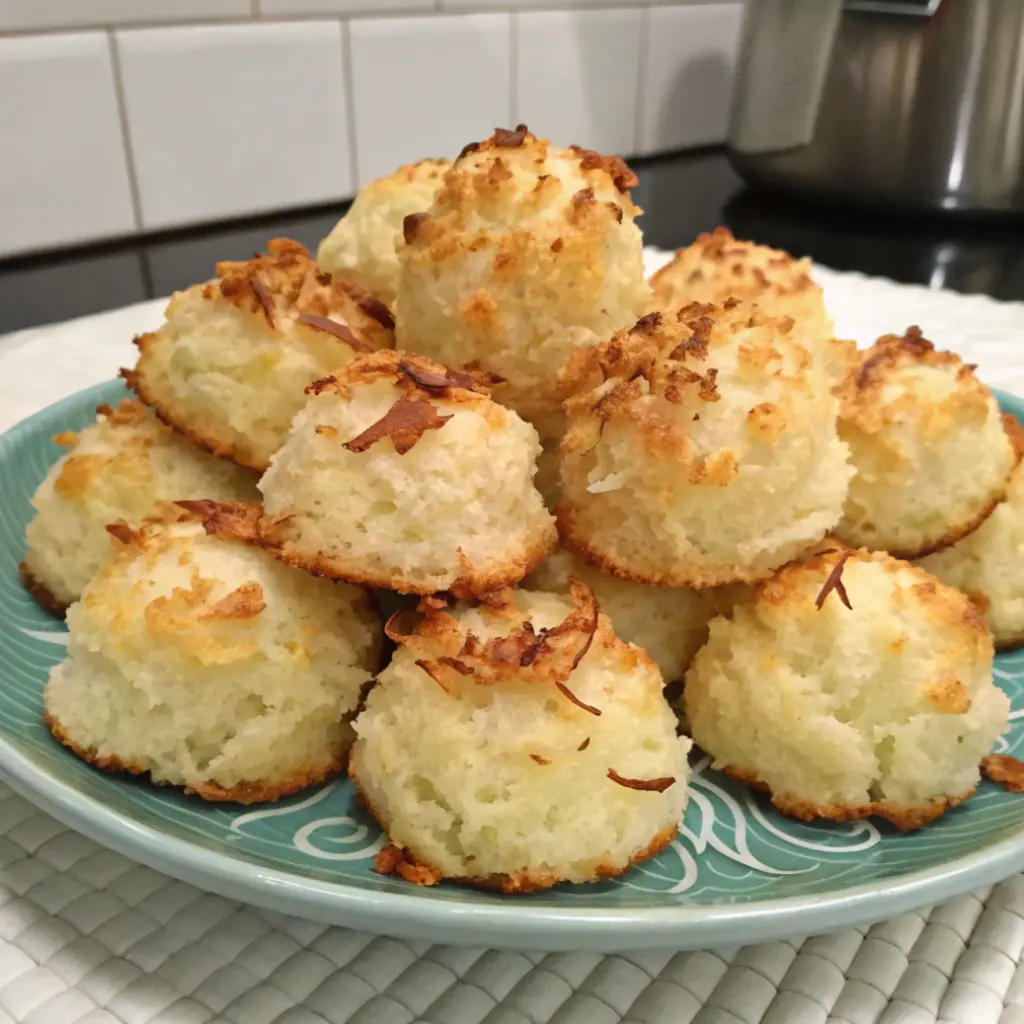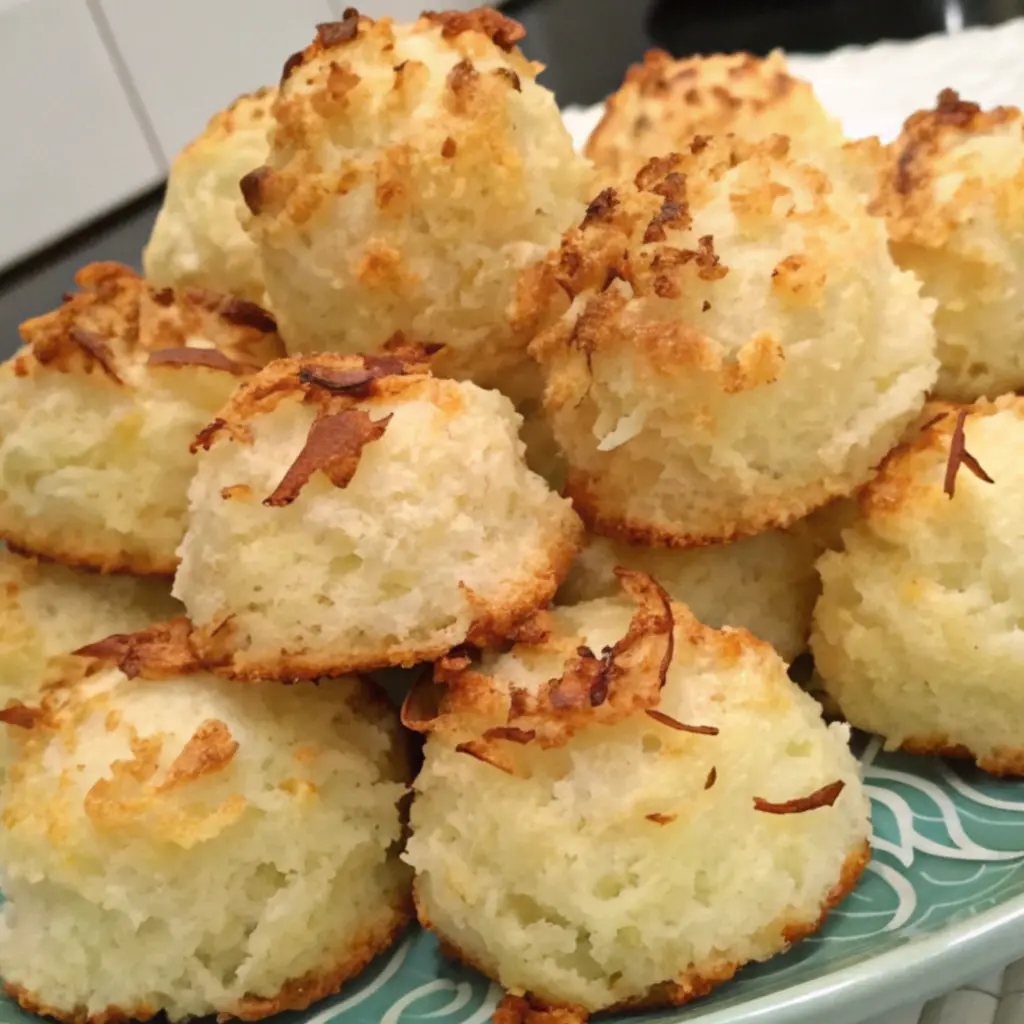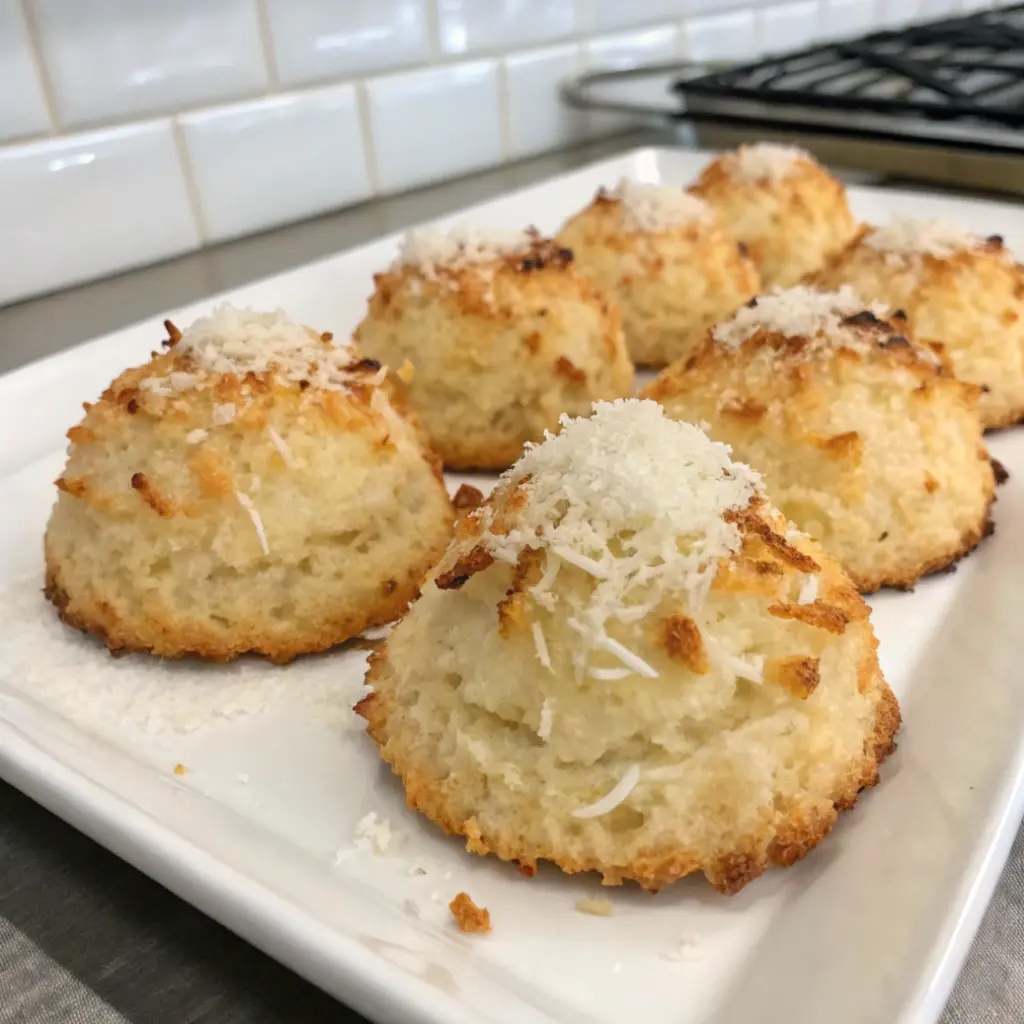I can still remember the first time I made coconut macaroons. It was during a gray, rainy afternoon in early spring—one of those quiet days when the world feels paused and the house smells of strong coffee and damp earth from the open windows. I’d just come home from the market with a bag of shredded coconut I bought on impulse, unsure what I was going to do with it. I had eggs, sugar, and not much else, but I was craving something sweet and comforting that didn’t ask too much of me. That first batch came out a little too golden around the edges, and the kitchen smelled like toasted coconut for hours. But the texture—the crisp edges and chewy, soft center—stayed with me. These little macaroons became something I returned to often, especially when I needed a recipe that didn’t require a full pantry, a clear mind, or even much time. Just a bowl, a spoon, and the desire to bake.

Why You’ll Love This Recipe:
- Requires only a few simple ingredients
- Naturally gluten-free and pantry-friendly
- Crispy outside with a tender, chewy inside
- Easy to dress up or down for any occasion
- Great make-ahead treat that stores well
Ingredients You’ll Need:
Sweetened shredded coconut (3 cups): I’ve tested unsweetened too, but it doesn’t have the same moisture or flavor. If you’re watching sugar, you can mix half sweetened and half unsweetened—just be ready for a slightly drier cookie.
Egg whites (4 large): Room temperature egg whites whip more evenly, but I’ll be honest—I’ve used them cold straight from the fridge in a pinch. Just make sure there’s no trace of yolk or grease in the bowl or they won’t whip properly.
Granulated sugar (¾ cup): This helps structure the macaroons and gives them that golden crispness. I’ve used coconut sugar before—it makes them darker and more molasses-y, which some people love.
Vanilla extract (1½ teaspoons): Go for real vanilla if you can. The fake stuff works in a rush, but it’s worth using the real deal here. Almond extract also makes a beautiful variation.
Salt (¼ teaspoon): Just a pinch rounds out the sweetness and makes the coconut sing.
How to Make It (Step-by-Step Instructions):
Start by preheating your oven to 325°F (163°C) and lining a baking sheet with parchment paper. I used to skip the parchment, thinking it was unnecessary, but after scrubbing too many sticky pans, I don’t make that mistake anymore. Coconut burns fast once it hits the hot metal.
In a large, clean mixing bowl, add your egg whites. I usually give the bowl a quick swipe with a bit of lemon juice or vinegar on a paper towel to make sure there’s no lingering fat that might prevent the whites from whipping. Using a hand mixer or stand mixer, beat the whites until soft peaks form—when the peaks tip over slightly but still hold shape. This step gives the macaroons structure and lift.
Gradually add in the sugar, a tablespoon or two at a time, continuing to beat until you reach glossy, firm peaks. The mixture should look satiny and hold a peak when you lift the beater. Stir in the vanilla and salt, gently folding to keep that airy texture intact.
Next, add the shredded coconut. This is where you put away the mixer and use a rubber spatula or even your hands. I’ve found that folding gently is key—you want to coat the coconut thoroughly without deflating the egg whites too much. The mixture should hold together when scooped but still look fluffy and textured.
Using a cookie scoop or two spoons, portion the mixture onto the prepared baking sheet, spacing them about an inch apart. They don’t spread much, so you can fit quite a few on one tray. I like to slightly pinch the tops to form little peaks—they toast beautifully and give each bite a bit of crunch.
Bake for about 20–25 minutes, or until the edges are golden and the tops look just kissed by the oven. Watch them carefully after the 18-minute mark; coconut can go from golden to burnt in no time. Let them cool completely on the baking sheet before moving. They’re fragile when hot but firm up beautifully as they cool.

Expert Tips for the Best Results:
Over the years, I’ve learned that the key to perfect macaroons is all in the moisture balance. If your mixture feels too dry, you can add a spoonful of egg white or even a touch of honey to bind it. On the flip side, if it’s too wet, the cookies will spread and bake unevenly—just add a bit more coconut. Beating the egg whites properly is essential—under-whipped and they collapse, over-whipped and they separate. And always cool them completely before storing; warm macaroons in a container turn soft and sticky fast.
Variations & Substitutions:
There was one time, a few Decembers ago, I ran out of vanilla and used almond extract instead—just half a teaspoon, since it’s stronger—and they turned out tasting like little bites of marzipan. Another time, I folded in mini chocolate chips and sprinkled a few sea salt flakes on top before baking. They were gone in hours. Dipping the bottoms in dark chocolate adds a bit of elegance if you’re taking them to a party, and I’ve even added chopped dried cranberries or orange zest for a festive twist. I once had to make them with half coconut and half crushed cornflakes—odd, I know, but surprisingly delicious.
Serving Suggestions:
These macaroons are lovely all on their own with a cup of coffee or tea, but I’ve also served them as part of a cookie tray during the holidays and they always disappear first. For a more polished dessert, dip the bottoms in dark chocolate and set them on a platter with fresh berries. I’ve even tucked them into little gift tins or wrapped them in wax paper for teacher gifts, and they hold up beautifully. They’re sweet but not cloying, so they make a nice finish after a rich meal when you just want a nibble of something light and coconutty.
Storage & Reheating Instructions:
I usually store my macaroons in an airtight container at room temperature for up to five days. If it’s especially humid, I’ll add a piece of paper towel to absorb moisture and keep them crisp. You can also freeze them—just pop them into a freezer bag once they’re fully cooled and defrost at room temp when you’re ready to enjoy. If you like them a bit warm, a quick 5-minute stint in a 300°F oven brings the crunch back to life without drying them out too much. Just don’t microwave them—they turn chewy in a way that’s not very pleasant.
Recipe FAQs (Answered by Clara):
Can I make these without beating the egg whites?
Technically, yes, but they won’t have the same light texture. I’ve tried the “everything in one bowl” method before, and the result is much denser. Still tasty, but different.
Can I use unsweetened coconut?
You can, but you may want to add a touch more sugar or honey to balance it out and help with moisture. The texture will be a bit rougher, but still good.
Can I freeze coconut macaroons?
Absolutely. I often make a double batch and freeze half. Just make sure they’re completely cool and stored in a well-sealed container.
Do I need to refrigerate them?
Nope. They’re best stored at room temperature, away from heat or moisture. Refrigeration actually makes them go soft faster.
Why did my macaroons spread out too much?
They were likely too wet. Try adding a little more coconut next time, or make sure you’ve beaten the egg whites to proper peaks.

Conclusion:
If you’ve never made coconut macaroons before, I hope this gives you the nudge to try. They’re one of those recipes that’s surprisingly forgiving, yet special enough to feel like a treat. Whether you bake them on a rainy afternoon like I did, or whip up a batch for a gathering, they always manage to bring a little comfort and joy. If you do give them a try, I’d love to hear how they turn out—drop a note, share your twist, or just enjoy them quietly with a warm drink. That’s the beauty of baking—it’s yours to make your own.
Nutrition Information (Per Cookie, Approximate):
Calories: 130 | Fat: 7g | Saturated Fat: 6g | Carbohydrates: 14g | Sugar: 12g | Protein: 2g | Fiber: 1g | Sodium: 30mg


Leave a Reply